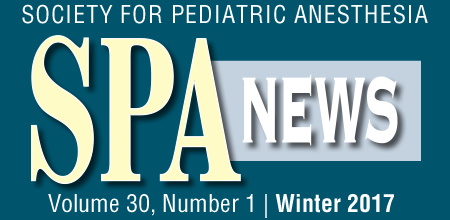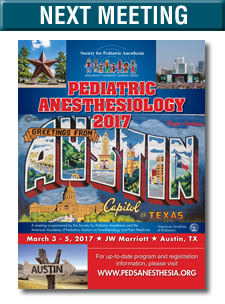Annual Meeting Reviews
Session II: Soup to Nuts - The Pediatric Perioperative Surgical Home
Reviewed by Jorge A. Gálvez, MD, MBI
Assistant Professor of Anesthesiology & Critical Care Medicine
The Children’s Hospital of Philadelphia
The much-anticipated session on the Pediatric Perioperative Surgical Home was moderated by Samuel Wald and focused on examples of pediatric perioperative surgical home models.
Speaker #1: “Overview: Patient-Centered, Physician Lead, Interdisciplinary Coordinated Care”
Lynne Ferrari MD from Boston Children’s Hospital presented on “Overview: Patient-Centered, Physician Lead, Interdisciplinary Coordinated Care” focusing on the rationale for the surgical home model in pediatric hospitals. The ultimate goal is to provide improved services while reducing the need for expensive interventions such as prolonged hospitalizations. Cost savings resulting from perioperative surgical home models can be distributed to hospitals and healthcare providers as a result of improved care and reduced resource utilization. Dr. Ferrari highlighted models that provide cost-savings sharing between hospitals and healthcare providers groups based on demonstrated value savings from perioperative surgical home protocol adherence.
Perioperative surgical home models rely on identification of procedures that have the highest relative burden of preventable complications and cost variation. It is ideal to target the areas with the greatest overlap between high complications and high-cost variability. Examples of pediatric perioperative surgical home models include:
- Cerebral Palsy
- Congenital Craniofacial Abnormalities
- Down Syndrome
- Childhood Neoplastic Disease
- Scoliosis (idiopathic and neuromuscular)
- Cyanotic Congenital Heart Disease
- Hydrocephalus
- Sickle Cell Disease
One of the challenges for the pediatric perioperative surgical home initiative is to identify appropriate metrics. Adult perioperative surgical home models have focused on decreasing length of stay, readmission rates, cost of episode, and utilization of expensive hospital resources.
According to data from the Pediatric Health Information System (https://www.childrenshospitals.org/programs-and-services/data-analytics-and-research/pediatric-analytic-solutions/pediatric-health-information-system) and the Kaiser Commission on Medicaid and the Uninsured (http://kff.org/health-reform/issue-brief/medicaid-moving-forward/) 0.5% of the pediatric population accounts for approximately 25% of care expenses. Using Medicare data, the aggregate cost of spine fusion surgeries was about 140 million dollars (10-15% for pre-operative care, 70% intraoperative + hospital care, and 10-15% for postoperative care). Hospitalization and intraoperative costs may provide areas of improvement and cost savings.
Pediatric re-admissions for post-surgical patients are quite different than in the adult population. The published 30-day readmission rates in pediatrics is 6.5% compared to 9.6% in adults. A large proportion of pediatric post-discharge readmissions are a result of medical needs from complex patients, and few are surgical related.1
Dr. Ferrari concluded her presentation highlighting the triple-aim of all perioperative surgical home models. Can we:
- improve the individual experience for the patient,
- improve the health of the surgical population and
- reduce the cost?
The Society for Pediatric Anesthesia is excited to provide a forum to expand on these goals by hosting the first meeting of the Pediatric Perioperative Surgical Home (PPSH) special interest group.
The committee met for the first time after the conclusion of the fall meeting and will continue to meet at upcoming society meetings.
Speaker #2: "Enhanced Recovery in Scoliosis (The inpatient experience)”
Karen M. Thomson MD discussed the Pediatric Perioperative Surgical Home model for scoliosis surgery at Children’s National Hospital. Her presentation focused on the details beginning with stakeholder assessment and team development.
The team followed a Lean Six Sigma approach and developed a detailed process map of the entire process of undergoing spine fusion surgery. The final plan consisted of six pages and had 79 storm clouds, which are areas identified as opportunities to improve. One storm cloud focused on the myth that patients with patient-controlled analgesia (PCA) devices required a Foley catheter. In their practice, this practice was not standardized and varied based on who was staffing the pain service. Similarly, there were no standards for removing the Foley catheter, or the surgical dressing.
The ultimate goal of the process was to address as many storm clouds as possible. To the extent that it was possible, the group focused on evidence-based recommendations, but often there was no evidence to support a particular practice. In these cases, the team assisted in the process of developing standards with input from stakeholders. Various interventions considered and implemented included enhanced recovery after surgery (ERAS) pathways, pre-operative autologous blood collection, iron supplementation, laxative regimens, pre-operative education, and establishment of a patient database. The team developed a standard approach for intra-operative management, which focuses on patient warming and goal-directed therapy.
Finally, the pediatric perioperative surgical home team promotes communication across the practice. They hold quarterly debriefings to discuss previous achievements, challenges, and opportunities for the future.
Thomson’s group is continuing to develop the model and has recently published the preliminary results of their project.2 They have demonstrated a reduction in transfusions from 30 to 11%, improved pain management with reduced pain scores, reduced opioid use, reduced ICU stay and hospital length of stay.
The presentation concluded with a discussion of the barriers to success and what it takes to succeed. The team encountered many obstacles. Rather than looking at obstacles as barriers, they focused on how to “get around” the obstacle. The team focused on change management from leadership to stakeholders. Specifically, Dr. Thomson mentioned the WIFM approach: “what’s in it for me” guidelines.
At Children’s National, they have relied heavily on the information technology infrastructure. They developed order sets that facilitated the integration of the necessary processes for pre- Intra- and post- procedure management.
In closing, Dr. Thomson signaled to the future of the Pediatric Perioperative Surgical Home projects at Children’s National, focusing on Sickle Cell Patients, adolescent, and adult congenital heart conditions, and patients with Gastrostomy feeding tubes.
Speaker #3: “Enhanced Encounter in Adenoidectomy (The outpatient experience)”
Vidya Raman MD (Nationwide Children’s Hospital) led the final session that discussed the experience of enhanced recovery after Adenoidectomy; a procedure that had a high-cost burden and a high case volume.
The approach shared a common path with those described before focusing on pre-operative, intra-operative and post-operative areas to identify opportunities for improvement. The surgeons identified potential candidates for the perioperative surgical home process during the initial clinic visit. The electronic health record was configured to create a particular header label to identify patients in the perioperative surgical home group clearly. Furthermore, order sets were standardized.
Patients and families received specific education to prepare them for the day of surgery as well as the recovery period. An educational video was posted on youtube and distributed to all patients and their families (www.youtube.com/watch?v=u3W3yYigSa0).
On the day of the procedure, all patients were prescribed oral acetaminophen and offered pre-induction midazolam. The intra-procedure medication regimen was also standardized with an emphasis to avoid intravenous acetaminophen and intravenous dexmedetomidine. The anesthesiologists also agreed to switch from using sevoflurane to isoflurane for maintenance of anesthesia.
Most patients are discharged to home from the post-anesthesia recovery unit following the adenoidectomy. All anesthesiologists call their patients on the evening after completion of the procedure and follow a post-operative call script. This intervention was difficult to implement due to time constraints for providers, but it drastically improved patient satisfaction.
Ultimately, the outpatient perioperative surgical home model for adenoidectomy achieved improvements in patient satisfaction as well as cost-savings from reduced hospital length of stay. The group learned to overcome barriers around inter-disciplinary communication between pre-admission testing, surgeon, anesthesiologist, post-anesthesia care unit and ambulatory surgery centers on the road to implementation. Dr. Raman’s work is another example that the benefits of improved patient care and reduced resource utilization are valuable rewards of implementing a perioperative surgical home initiative.
---
Transcript of audience questions:
Q: Pre-operative consideration: In extremely complex patients, we should step back and consider whether the surgery is appropriate. Does the surgery meet the patient’s and family’s goals?
A: (Lynn Ferrari) Boston Children’s has a multi-disciplinary group that discusses the appropriateness of a surgical intervention and whether the risk is too high. The process includes stakeholders from various subspecialties as needed. Anesthesiologists are valuable contributors in this process.
Q: I am a little worried about initiatives that streamline the process and cost, specifically limiting access to certain medications like intravenous acetaminophen and dexmedetomidine. There are ways to mitigate these expenses, such as pharmacy preparation of the medications that can split one vial into several syringes for single administration.
A: (Karen Thomson) The way we addressed this problem was by integrating intravenous acetaminophen into the pathway until they were able to take oral medications. At this point, this was an expert-opinion decision. In the future, it will be important to conduct cost-effectiveness research. Important questions that have not been answered include: Does it make the pain score better? Does it affect PACU discharge time? To the extent that it is possible, these decisions should be evidence based.
Q: I am dismayed that the financial data presented uses cost / charge / payments interchangeably. These terms are not interchangeable. There is a trend of hospital charges going up steeply, and if 5% of the payers pay a small percentage of the charge, why not go up on the charge? For future, consider presenting data based on the reimbursements from payors rather than the charges.
A: (Lynne Ferrari) The laryngeal cleft data that was presented was focusing specifically on the cost. It should be noted that it was very difficult to get accurate data on the ‘cost’. It is easier to obtain data from charges. Each institution has a unique charge structure based on their own practice. The clarification of cost versus charge is very important and should not be used interchangeably.
Q: One of the variables that aren't accounted for in these studies is the time and effort to conduct the quality improvement studies. Non-clinical time doesn’t show up in any of the graphs of cost-savings. It is costing someone hundreds of thousands of dollars for your time. For example, shutting the operating room down one day per week so that everyone can work together to solve these problems would be ideal, but this would be a big expense that no one is willing to do.
A: (Lynne Ferrari) This is a question of monetizing this work. How do you pay for someone’s time to do this work? If you think about it, a lot of the charge for anesthesiologists is the intraoperative time. If we are going to be compensated for the work that we do outside of the operating room, we have a responsibility to demonstrate the value added for this work. What is the impact of what we are doing for the episode of care? Once you can identify the value added that we provide, we can say that we deserve to be compensated for this work outside of the operating room and not just the operating room minutes.
Comment: As a department Chair, I need to justify sending an anesthesiologist half a day to the pre-operative evaluation setting. These initiatives do result in a reduction of cost to the hospital but rarely is that cost-reduction returned to the department in the form of financial compensation. On a separate note, improving productivity and increasing capacity for additional case volume without increasing operational costs (i.e. two procedures in the time that it used to take to do one) should result in increased reimbursement. However, these gains are rarely seen by the anesthesiology departments.
Q: It is difficult to manage change and to get individuals to adopt a change in their practice. How did you manage this?
A: (Karen Thomson) We did not say that our entire group was not able to care for patients undergoing spine fusion. But it is easier to work with a small group rather than a large group. We allowed individuals to contribute to and develop the protocols. Our expectation is that if you want to be part of the team, that you follow the protocol. We also rotate people on and off the team, this way it is not an exclusive team.
References:
-
Berry JG, Toomey SL, Zaslavsky AM, Jha AK, Nakamura MM, Klein DJ, Feng JY, Shulman S, Chiang VW, Kaplan W, Hall M, Schistr MA. JAMA. 2013;309(4):372-380.
-
Thomson K, Pestieau SR, Patel JJ, Gordish-Dressman H, Mirada A, Kain ZN, Oetgen ME. Perioperative Surgical Home in Pediatric Settings: Preliminary Results. Anesthesia & Analgesia. November 2016 - Volume 123 - Issue 5 - p 1193–1200.





